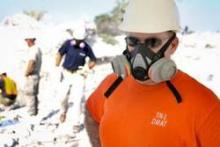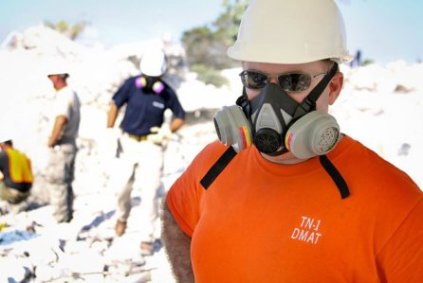User login
Care of critically ill or injured patients during Hurricane Sandy, the 2010 earthquake in Haiti, and the H1N1 influenza pandemic in Mexico City played a role in shaping new recommendations from the American College of Chest Physicians.
The 14-part consensus statement from the College’s Task Force for Mass Critical Care updates and expands on the task force’s previous recommendations from 2008, which did not address pediatrics, trauma, subspecialty critical care, or critical care during disasters in the developing world, among other topics.
Although there is some overlap with the 2008 recommendations, "by and large the specific suggestions are all new or have been updated since the 2008 guidelines, based upon lessons learned from pandemics and disasters that have occurred in the interval," Dr. Jeffrey R. Dichter said in an interview.
If history is any guide, clinicians will want to incorporate the 2014 recommendations as a matter of routine instead of placing them on a shelf only to be retrieved in times of crisis, said Dr. Dichter, a member of the task force. He is medical director for intensive care at Unity Hospital, Fridley, Minn., and a past president of the Society of Hospital Medicine.
The task force heard from colleagues that the 2008 document helped them plan to scale up ICU capacity and manage ventilated patients during the 2009 Mexican influenza epidemic – plans that they did not need to implement but that gave them reassurance nonetheless.
Triage guidelines in the 2008 document helped Bellevue Hospital in New York plan for allocating scarce resources such as electricity from backup generators during 2012’s Hurricane Sandy, a hospital physician reported at the College’s 2013 annual meeting. "Simply knowing they had an approach in place to make those decisions if required allowed the staff to focus on dealing with the situation at hand effectively rather than being distracted by the uncertainty of what would happen if the generators failed," Dr. Dichter said.
The 2014 document’s attention to evacuation of critically ill and injured patients should be of particular interest. "We have seen the challenge related to evacuating ICUs, particularly during the New York hurricane," he said.
Another highlight is a focus on developing the capacity to increase health care personnel and supplies when needed (also known as "surge response") to meet disasters of various sizes – small, medium, or large. The previous recommendations covered only the largest, "crisis" care.
The document provides advice for everyone from individual doctors to hospital administrators, regional health systems, and national governments. "While it is important for all health care workers to have a broad understanding of the issues of emergency preparedness, readers can focus on the areas more relevant to them by consulting the tables in each document" that identify the people for whom those recommendations are most relevant, he said.
The recommendations are based on expert consensus because there is no research to support evidence-based guidelines, the task force stated. That should change by the time the recommendations are updated again in the future, Dr. Dichter said. Groups such as the International Forum for Acute Care Trialists and the International Severe Acute Respiratory and Emerging Infection Consortium are starting to conduct research during pandemics and disasters.
And, of course, more crises will occur, providing experience that will help improve planning for the next inevitable disaster.
Dr. Dichter reported having no financial disclosures.
On Twitter @sherryboschert
The consensus statement moves forward planning for critical care during pandemics and disasters in unprecedented ways, Dr. Christian Sandrock said in an editorial.
 |
|
The principles behind recommendations for conservation of personnel and supplies (particularly scarce medications and oxygen therapy), substitutions where necessary, and triage "are very relevant today where the resource limitations in West Africa are hindering both patient care and management outbreak," wrote Dr. Sandrock.
Emphases on technology and telemedicine, baseline education plus just-in-time training, and mental health support during disasters should help support health care workers on the front lines to deliver the best care possible, he added.
A goal of "a 20% increase in surge within the health-system resources to a 200% surge with regional and national resource support sets an international benchmark for health-system preparedness," Dr. Sandrock wrote.
Recommendations for coordinating patient flow and resources at a regional level have "not been described elsewhere," and the task force’s vision of incorporating critical care expertise in large, central coordination of patient flow, resources, and care "sets a high but necessary benchmark for public health and government officials," he wrote.
Perhaps the greatest contribution of the document is its attention to potential health care inequities during disasters and the need for ethical and equal care, Dr. Sandrock suggested. The consensus statement provides "a foundation of disaster response for the critically ill that provides justice to the most adversely affected patients," which is an unparalleled accomplishment, he wrote.
Dr. Sandrock is in the division of pulmonary and critical care medicine at the University of California, Davis.
The consensus statement moves forward planning for critical care during pandemics and disasters in unprecedented ways, Dr. Christian Sandrock said in an editorial.
 |
|
The principles behind recommendations for conservation of personnel and supplies (particularly scarce medications and oxygen therapy), substitutions where necessary, and triage "are very relevant today where the resource limitations in West Africa are hindering both patient care and management outbreak," wrote Dr. Sandrock.
Emphases on technology and telemedicine, baseline education plus just-in-time training, and mental health support during disasters should help support health care workers on the front lines to deliver the best care possible, he added.
A goal of "a 20% increase in surge within the health-system resources to a 200% surge with regional and national resource support sets an international benchmark for health-system preparedness," Dr. Sandrock wrote.
Recommendations for coordinating patient flow and resources at a regional level have "not been described elsewhere," and the task force’s vision of incorporating critical care expertise in large, central coordination of patient flow, resources, and care "sets a high but necessary benchmark for public health and government officials," he wrote.
Perhaps the greatest contribution of the document is its attention to potential health care inequities during disasters and the need for ethical and equal care, Dr. Sandrock suggested. The consensus statement provides "a foundation of disaster response for the critically ill that provides justice to the most adversely affected patients," which is an unparalleled accomplishment, he wrote.
Dr. Sandrock is in the division of pulmonary and critical care medicine at the University of California, Davis.
The consensus statement moves forward planning for critical care during pandemics and disasters in unprecedented ways, Dr. Christian Sandrock said in an editorial.
 |
|
The principles behind recommendations for conservation of personnel and supplies (particularly scarce medications and oxygen therapy), substitutions where necessary, and triage "are very relevant today where the resource limitations in West Africa are hindering both patient care and management outbreak," wrote Dr. Sandrock.
Emphases on technology and telemedicine, baseline education plus just-in-time training, and mental health support during disasters should help support health care workers on the front lines to deliver the best care possible, he added.
A goal of "a 20% increase in surge within the health-system resources to a 200% surge with regional and national resource support sets an international benchmark for health-system preparedness," Dr. Sandrock wrote.
Recommendations for coordinating patient flow and resources at a regional level have "not been described elsewhere," and the task force’s vision of incorporating critical care expertise in large, central coordination of patient flow, resources, and care "sets a high but necessary benchmark for public health and government officials," he wrote.
Perhaps the greatest contribution of the document is its attention to potential health care inequities during disasters and the need for ethical and equal care, Dr. Sandrock suggested. The consensus statement provides "a foundation of disaster response for the critically ill that provides justice to the most adversely affected patients," which is an unparalleled accomplishment, he wrote.
Dr. Sandrock is in the division of pulmonary and critical care medicine at the University of California, Davis.
Care of critically ill or injured patients during Hurricane Sandy, the 2010 earthquake in Haiti, and the H1N1 influenza pandemic in Mexico City played a role in shaping new recommendations from the American College of Chest Physicians.
The 14-part consensus statement from the College’s Task Force for Mass Critical Care updates and expands on the task force’s previous recommendations from 2008, which did not address pediatrics, trauma, subspecialty critical care, or critical care during disasters in the developing world, among other topics.
Although there is some overlap with the 2008 recommendations, "by and large the specific suggestions are all new or have been updated since the 2008 guidelines, based upon lessons learned from pandemics and disasters that have occurred in the interval," Dr. Jeffrey R. Dichter said in an interview.
If history is any guide, clinicians will want to incorporate the 2014 recommendations as a matter of routine instead of placing them on a shelf only to be retrieved in times of crisis, said Dr. Dichter, a member of the task force. He is medical director for intensive care at Unity Hospital, Fridley, Minn., and a past president of the Society of Hospital Medicine.
The task force heard from colleagues that the 2008 document helped them plan to scale up ICU capacity and manage ventilated patients during the 2009 Mexican influenza epidemic – plans that they did not need to implement but that gave them reassurance nonetheless.
Triage guidelines in the 2008 document helped Bellevue Hospital in New York plan for allocating scarce resources such as electricity from backup generators during 2012’s Hurricane Sandy, a hospital physician reported at the College’s 2013 annual meeting. "Simply knowing they had an approach in place to make those decisions if required allowed the staff to focus on dealing with the situation at hand effectively rather than being distracted by the uncertainty of what would happen if the generators failed," Dr. Dichter said.
The 2014 document’s attention to evacuation of critically ill and injured patients should be of particular interest. "We have seen the challenge related to evacuating ICUs, particularly during the New York hurricane," he said.
Another highlight is a focus on developing the capacity to increase health care personnel and supplies when needed (also known as "surge response") to meet disasters of various sizes – small, medium, or large. The previous recommendations covered only the largest, "crisis" care.
The document provides advice for everyone from individual doctors to hospital administrators, regional health systems, and national governments. "While it is important for all health care workers to have a broad understanding of the issues of emergency preparedness, readers can focus on the areas more relevant to them by consulting the tables in each document" that identify the people for whom those recommendations are most relevant, he said.
The recommendations are based on expert consensus because there is no research to support evidence-based guidelines, the task force stated. That should change by the time the recommendations are updated again in the future, Dr. Dichter said. Groups such as the International Forum for Acute Care Trialists and the International Severe Acute Respiratory and Emerging Infection Consortium are starting to conduct research during pandemics and disasters.
And, of course, more crises will occur, providing experience that will help improve planning for the next inevitable disaster.
Dr. Dichter reported having no financial disclosures.
On Twitter @sherryboschert
Care of critically ill or injured patients during Hurricane Sandy, the 2010 earthquake in Haiti, and the H1N1 influenza pandemic in Mexico City played a role in shaping new recommendations from the American College of Chest Physicians.
The 14-part consensus statement from the College’s Task Force for Mass Critical Care updates and expands on the task force’s previous recommendations from 2008, which did not address pediatrics, trauma, subspecialty critical care, or critical care during disasters in the developing world, among other topics.
Although there is some overlap with the 2008 recommendations, "by and large the specific suggestions are all new or have been updated since the 2008 guidelines, based upon lessons learned from pandemics and disasters that have occurred in the interval," Dr. Jeffrey R. Dichter said in an interview.
If history is any guide, clinicians will want to incorporate the 2014 recommendations as a matter of routine instead of placing them on a shelf only to be retrieved in times of crisis, said Dr. Dichter, a member of the task force. He is medical director for intensive care at Unity Hospital, Fridley, Minn., and a past president of the Society of Hospital Medicine.
The task force heard from colleagues that the 2008 document helped them plan to scale up ICU capacity and manage ventilated patients during the 2009 Mexican influenza epidemic – plans that they did not need to implement but that gave them reassurance nonetheless.
Triage guidelines in the 2008 document helped Bellevue Hospital in New York plan for allocating scarce resources such as electricity from backup generators during 2012’s Hurricane Sandy, a hospital physician reported at the College’s 2013 annual meeting. "Simply knowing they had an approach in place to make those decisions if required allowed the staff to focus on dealing with the situation at hand effectively rather than being distracted by the uncertainty of what would happen if the generators failed," Dr. Dichter said.
The 2014 document’s attention to evacuation of critically ill and injured patients should be of particular interest. "We have seen the challenge related to evacuating ICUs, particularly during the New York hurricane," he said.
Another highlight is a focus on developing the capacity to increase health care personnel and supplies when needed (also known as "surge response") to meet disasters of various sizes – small, medium, or large. The previous recommendations covered only the largest, "crisis" care.
The document provides advice for everyone from individual doctors to hospital administrators, regional health systems, and national governments. "While it is important for all health care workers to have a broad understanding of the issues of emergency preparedness, readers can focus on the areas more relevant to them by consulting the tables in each document" that identify the people for whom those recommendations are most relevant, he said.
The recommendations are based on expert consensus because there is no research to support evidence-based guidelines, the task force stated. That should change by the time the recommendations are updated again in the future, Dr. Dichter said. Groups such as the International Forum for Acute Care Trialists and the International Severe Acute Respiratory and Emerging Infection Consortium are starting to conduct research during pandemics and disasters.
And, of course, more crises will occur, providing experience that will help improve planning for the next inevitable disaster.
Dr. Dichter reported having no financial disclosures.
On Twitter @sherryboschert
FROM CHEST


